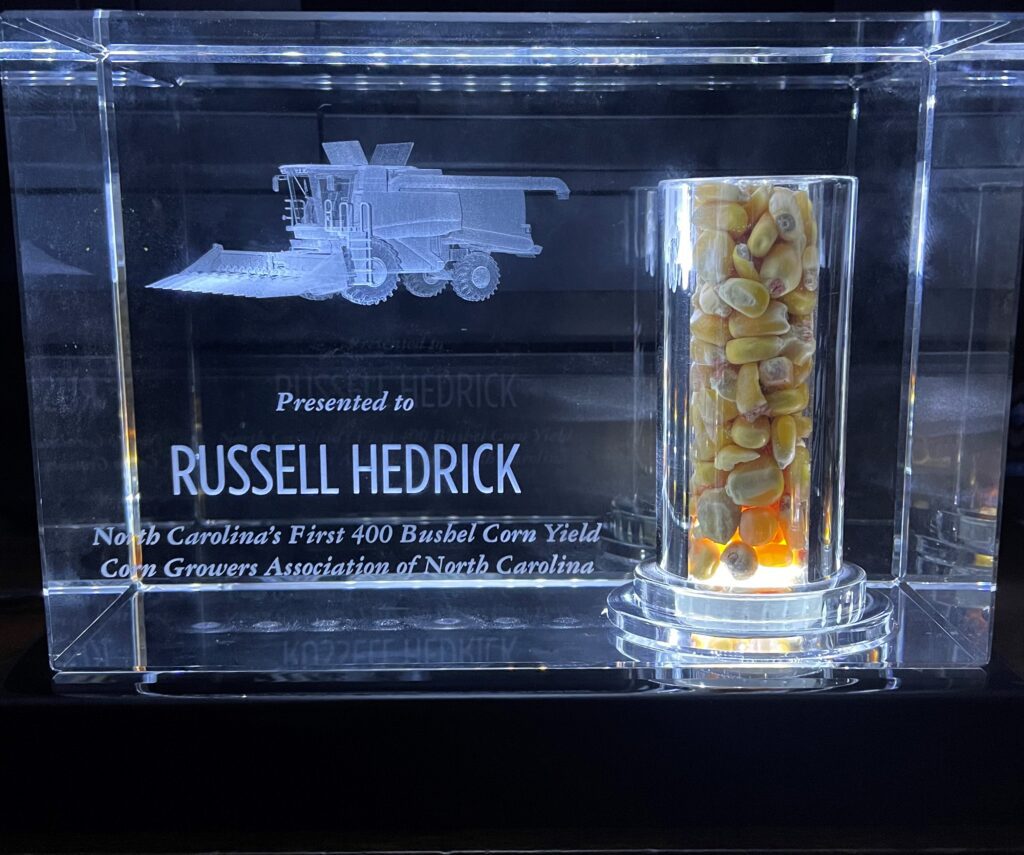Note: This is the third of a four-part series. Read the first and second parts of the series and then check back next week for part four.
 How does a first-generation farmer crush yield records in his first decade of operation? AgVenture grower Russell Hedrick has a unique story of how he left his career as a firefighter and embraced high-yield farming as a way of life.
How does a first-generation farmer crush yield records in his first decade of operation? AgVenture grower Russell Hedrick has a unique story of how he left his career as a firefighter and embraced high-yield farming as a way of life.
“There’s no proprietary secret to what we do,” said Hedrick, who recorded 459.51 bushels per acre dryland yield in the 2022 North Carolina State Yield Contest. “We do a lot of field walking. As a farmer, the visual indicators of getting out in the field – seeing the crop conditions, weed pressure, disease pressure – really being able to see that with your own eyes, that is so valuable. Doing your own agronomy work, versus having standard scouting done by other people, helps us make better management decisions and see a higher return on investment. That’s why we walk so many fields.”
It takes more than just walking fields to produce a record-setting yield. In fact, that’s what makes the AgVenture brand such a perfect fit for Hedrick: the focus on high-quality seed, industry-best seed treatments, and never giving up on the crop. But even before he started planting AgVenture products, he knew the importance of his in-field observations. He spends time researching new technologies and techniques, particularly when it comes to soil testing.
In 2013, he began using the Haney test, which integrates chemical and biological measurements to assess the soil nutrient status, microbial biomass and aspects of the microbial habitat to determine overall soil health[1].
“It gives me additional forms of nitrogen that are more efficient in plant utilization and also more stable in the soil solution,” Hedrick said. “The test uses a different extraction method that gives us a more realistic view of what our nutrient availability is.”
Hedrick also credits AquaSpy, which he began using in 2014, for understanding how plants utilize moisture from the soil.
The AquaSpy intelligent, cloud-based IOT Agriculture platform connects the grower with specific crop plant behavior and needs, providing actionable information leading to better yields, proactive water conservation and informed soil management – the core components of regenerative agriculture[2].
“Why does corn use its moisture between 2 and 3 a.m.?” Hedrick asked. “There are so many things we can look at, like ‘When do we apply nutrients?’ We started running a y-drop between sundown and midnight to reduce the loss of nitrogen.”
 Of course, Hedrick relies on tissue sampling multiple times throughout the season to ensure the crop isn’t falling short on any nutrients. His approach asks, “Is what we’re actually applying getting into the plant and correlating into yield at the end of the season?”
Of course, Hedrick relies on tissue sampling multiple times throughout the season to ensure the crop isn’t falling short on any nutrients. His approach asks, “Is what we’re actually applying getting into the plant and correlating into yield at the end of the season?”
He estimates that about 90 percent of his corn acres receive a minimum of two nutrient passes. On contest plots, Hedrick said it is not uncommon to run six or seven passes and spoon-feed the crop along as they push for maximum yields.
When it comes to foliar feeding, he said they pay attention to relative humidity and environmental stress to determine whether or not a foliar feed is profitable. Once that decision is made, they will determine the best time for application.
“We don’t foliar feed while the sun is out,” he explained. “Typically we do it any time between 9 p.m. and 4 a.m. We want the leaves to be unrolled for maximum coverage. Plants have to transpire to pull nutrients in, so we want to be in that timeframe where everything we apply is moving into the plant.”
He admits it took multiple years of testing to get the timing just right. The same is true for determining the most essential micronutrients. Besides nitrogen, potassium and phosphorus, Hedrick says the biggest payoff has been boron.
“We have pushed way beyond the levels of what we were told would cause boron toxicity without seeing any detriment to the plant,” he said. “We are actually seeing better nutrient utilization within the plant. As we see boron levels increase through tissue sampling, we are realizing that boron helps move nutrition through the plant.”
Hedrick also uses molybdenum in very low doses, as well as nickel sulfate.
“Most guys that are seeing tar spot issues in the Midwest are coming up deficient in nickel in the places they are having big infestations,” Hedrick said. “So we are paying attention to these three key micronutrients on our farm.”
But what about the conservation practices that got Hedrick started in regenerative farming?
“I don’t think soil health trumps agronomy,” he said. “At the end of the day, if we’re scouting and we see a disease, we’re going to spray a fungicide. If we have a pest infestation in our fields, we’re going to spray an insecticide, if that’s what it comes to in order to save the crop.
“I think that’s the best way we can farm where we’re at and in our context.”
In the fourth and final part of our series, we will look at what happened in 2022 to make AV9916AM™ achieve a record yield.
[1] Regen Ag Lab. https://regenaglab.com/services/soil-health-analysis/
[2] AquaSpy. https://aquaspy.com/about-aquaspy/